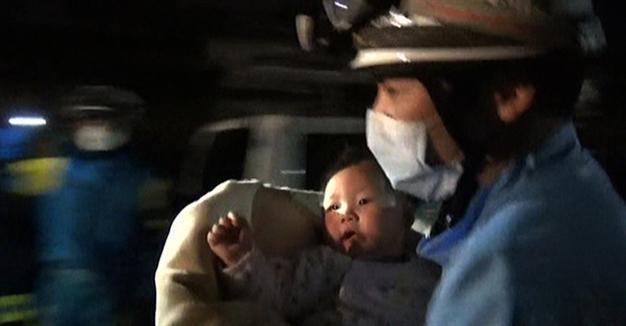Aftershocks rattle southwestern Japan after quake kills nine
TOKYO - Reuters

This handout image taken from video footage released by the Kumamoto Prefectural Police on April 15, 2016 shows a rescue worker carrying an eight-month-old baby girl after she was pulled from the rubble following an earthquake in Mashiki, Kumamoto Prefecture - AFP photo
Aftershocks rattled southwestern Japan on April 15 after a strong quake the night before killed nine people, injured at least 1,000 and cut power and water across the region, forcing the temporary shutdown of several auto and electronics factories.
By afternoon, more than 130 aftershocks had hit the area around the city of Kumamoto in the wake of the initial 6.4 magnitude quake the night before. Officials said the frequency was tapering off but the risk of further strong aftershocks will remain for about a week.
While the magnitude of the quake was much lower than that of the 9.0 March 11, 2011 quake that touched off a massive tsunami and nuclear meltdowns at Fukushima, the intensity was similar because it struck on land and at a much shallower depth.
"We managed to huddle into a space, that's why we were saved," one man told NHK national television after he and his family were rescued from their collapsed house two hours after the quake hit. "We're all safe, that's what counts."
More than 44,000 people initially fled to schools and community centres, some spending the night outside after the first quake hit around 9:30 p.m.
Roads cracked, houses crumbled, and tiles cascaded from the roof of the 400-year-old Kumamoto Castle in the centre of the city.
Among those pulled from the wreckage was an eight-month-old baby girl, wrapped in a blanket and passed hand to hand by firefighters. Several hospitals had to evacuate patients.
Japanese stocks ended down 0.4 percent, with the impact of the quake limited primarily to regional shares that could experience some direct impact. Regional utility Saibu Gas Co Ltd finished 2.7 percent lower.
Several companies, including Honda Motor Corp, suspended operations at plants in the area.
More than 3,000 troops, police and firemen were dispatched to the area from around Japan, and Prime Minister Shinzo Abe said more would be sent if needed.
"We will do everything in our power to ensure the safety of local residents," Abe told a parliamentary committee.
Most of the dead came from Mashiki, a town of around 34,000 people near the epicentre of the quake, where firefighters battled a blaze late on April 14. Daylight showed splintered houses under tiled roofs and an apartment building whose ground floor was pulverized, where two people died.
"I want to go home, but we couldn't do anything there," one boy at an evacuation centre told TBS television as he bounced a baby in his arms.
Though the intensity of the quake on April 14 on the Japanese scale matched that of the March 2011 quake that left nearly 20,000 dead, the absence of a tsunami helped keep the death toll down.
Service on the Shinkansen superfast train in Kyushu was halted after one train derailed, and highways were closed after some sections collapsed. About 12,200 households were without electricity as of 12 p.m. (0500 GMT), according to Kyushu Electric Power Co Inc, while some 58,000 lacked water.
The Nuclear Regulation Authority said there were no irregularities at three nuclear plants on the southern major island of Kyushu and nearby Shikoku.
Sony Corp, Mitsubishi Electric Corp and tire maker Bridgestone Corp also suspended operations at factories in the area.
The 2011 quake temporarily crippled part of Japan's auto supply chain, but some companies have since adjusted the industry's "Just in Time" production philosophy in a bid to limit any repeat of the costly disruption.
